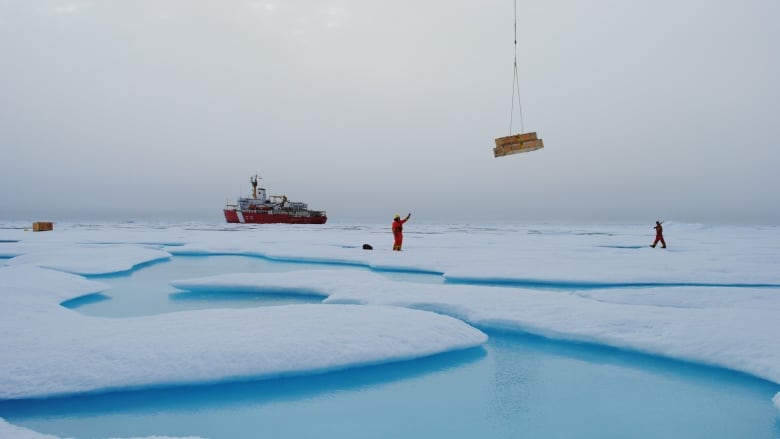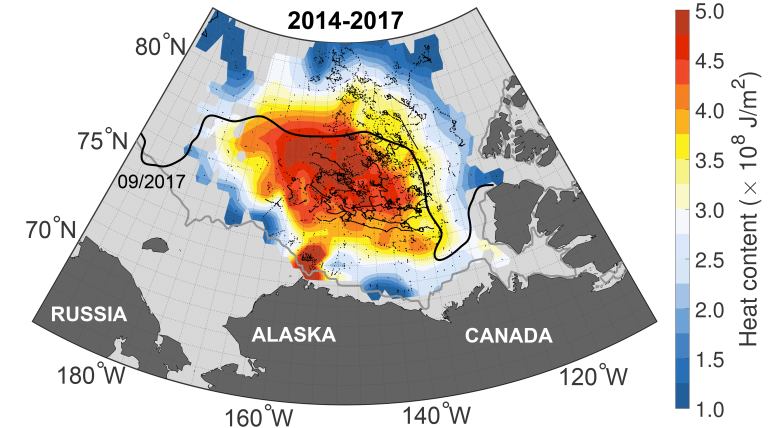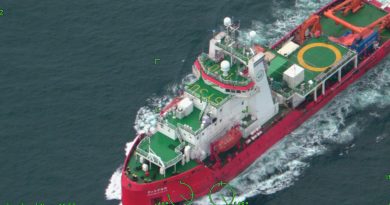Warm water under Arctic ice a ‘ticking time bomb,’ researcher says

A pocket of warm ocean water underneath the surface of the Canada Basin could melt a significant portion of the region’s sea ice pack if it were to ascend, a new study suggests.
The study, published in Science Advances by researchers from Yale University and Woods Hole Oceanographic Institution, looked at temperatures in the Canada Basin from the past 30 years. The basin in the Arctic Ocean is north of Alaska and parts of Yukon and the Northwest Territories.
It typically has a warm layer of water about 50 metres below the surface, a previously known feature in the western Arctic.

Warm water typically floats, because it’s lighter than cold water. But in the basin, the warm water doesn’t float because it’s insulated and the saltiness makes it heavy enough to sink. The colder, fresher water sits above, near the sea ice.
The study found that over the past 30 years the amount of heat in the the warm layer has doubled.
Warm water pushed in from outlying areas
Scientists believe the warm water is coming from the edges of the basin, places like the Northern Chukchi Sea, where every summer sea ice melts and retreats.

“That leaves a lot of open water exposed to the sun rays directly,” said Mary-Louise Timmermans, the lead author on the study.
The water at the edges of the basin gets warmer, scientists believe. Then, it is pushed deep under the surface layers and into the interior Arctic Ocean due to clockwise winds.
Heat not going away
Unlike other oceans, where deeper layers tend to have colder temperatures, the Arctic has been known to have a warmer subsurface, said co-author John Toole. But the sustained temperature increase in this warm layer was a surprise.
Toole calls the warming layer “a ticking time bomb.”
“That heat isn’t going to go away,” he said. “Eventually … it’s going have to come up to the surface and it’s going to impact the ice.”
Timmermans said the warm layer doesn’t pose an immediate threat to the sea ice overhead.
“That heat is very much insulated from the surface area,” she said.
The amount of heat diffused from the warm water to the cold water above is relatively small now, she said. For the heat to quickly affect other layers and the overlaying ice, something would need to happen to mix the separated waters, like a strong wind. “But wind input is largely buffered by sea ice cover sitting over top,” she said.

Another possibility would be if the salty waters eventually became so warm that, despite their saltiness, they stopped sinking and began mixing with the cold, fresh waters above, the paper notes.
But the small amount of upward heat diffusion may have a less dramatic, but still important effect — slightly warming the top layer, which could slow freeze up each year.
“It’s really difficult to say the extent to which it’s happening now,” Timmermans said. “That influence may increase going forward.”
Related stories from around the North:
Canada: Canadian study shows wildfires speeding up permafrost thaw, CBC News
Finland: Finland needs ambitious CO2 emissions cuts to fight climate change, say researchers, Yle News
Norway: New building to help boost cooperation for Arctic research center in Northern Norway, The Independent Barents Observer
Russia: Russian and American scientists team up to study Arctic Russia’s weakening sea ice, The Independent Barents Observer
Sweden: Melting ice brings down Sweden’s highest mountain peak, Radio Sweden
United States: Rapid Arctic warming is increasing the frequency of blizzards in U.S. Northeast: study, Radio Canada International




The graph axis labelled “Heat Content” is mislabeled.
Heat content is in joules/cubic meter. Joules/square meter/second is a heat flux. The graph needs to be recast with one or the other term. If the graph axis IS joules/cubic meter, the anomalous heat content ~10(+8) joules/ cubic meter is miniscule.
Water requires about 3850 joules per cubic meter to increase its temperature by one degree Celsius, while ice requires about 3.2×10(+6) joules per cubic to melt.
The Canadian basin has surface waters with an annual average about -1C, cooling to about -1.5C at 200 meters depth, and then warming to ~0.5C near 600 meters, while salinity rises from 30‰ to over 34‰ by 200 meters depth., remaining nearly constant to the greatest depths for the basin. Vertical stability, E, is strong over this variable regime. As is also well known, water moves along a neutral density surface and does not readily mix with water of different densities.
ARGO has found little change in heat content for the integrated Earth’s ocean, less than 1×10(+22) joules integrated over 700 meters depth from 2004 to 2013, the time frame in which heat content should be exponentially growing due to the anthropogenic effects of heating. Oceanographic data from 1960 to 2015 shows about +4×10(+22) joules integrated accumulation for the Earth’s ocean over the same depth range. This corresponds to only two days of solar heating for the planet, but spread over 50 years. That is an accumulation of ~ 0.05% of the solar heating during the 50 year period. Solar output variability is twice as large, over 0.1%. An accumulation so small is not significant; given the well-known climate oscillations and other potential short term anomalies, along with the solar variability.
ARGO observations over 50 years, along with improved calibration and experience in the interpretation of the data, will hopefully provide an accurate AND precise signal for ocean heat accumulation (or loss).
It was reassuring that the scientist in charge did not anticipate that these minute quantities would drastically affect Arctic Ocean sea ice in the near term (see the photo caption).